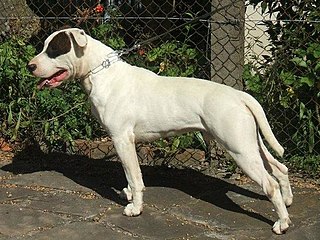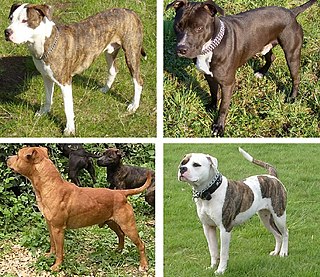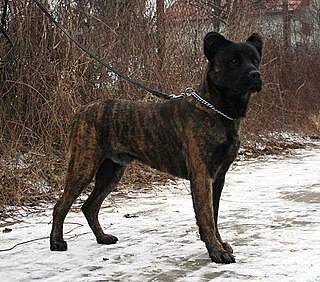 W
WThe Alano Español or Spanish Alano is a Spanish breed of large dog of molossoid type. The dogs have been used as cattle catch dogs, hunting, and guarding. It was formerly use during Spanish bullfights, and is sometimes called the Spanish Bulldog in English.
 W
WThe American Bulldog is a large breed of utility dog descended from the now-extinct Old English Bulldog. They are now used on animal farms, dog sports, and for showing. They are part of American culture and history, and may be used as a cultural icon for the United States. They are generally represented as being strong and tough. In November 2019, the American Bulldog was added to the American Kennel Club (AKC) Foundation Stock Service (FSS).
 W
WThe American Pit Bull Terrier (APBT) is a purebred dog breed recognized by the United Kennel Club (UKC) and the American Dog Breeders Association (ADBA), but not the American Kennel Club (AKC). It is a medium-sized, intelligent, short-haired dog, of a solid build, whose early ancestors came from the British Isles. When compared with the English Staffordshire Bull Terrier, the American Pit Bull Terrier is larger by margins of 6–8 inches (15–20 cm) in height and 25–35 pounds (11–16 kg) in weight. The American Pit Bull Terrier varies in size: males are normally about 18–21 inches (45–53 cm) in height and around 35–60 pounds (15–27 kg) in weight, while females are normally around 17–20 inches (43–50 cm) in height and 30–50 pounds (13–22 kg) in weight.
 W
WThe Barbado da Terceira is Portuguese breed of herding and guard dog from the Atlantic island of Terceira in the Azores, for which it is named. It was recognised by the Direcção-Geral de Veterinária of Portugal in 2004. It is not recognised by the Fédération Cynologique Internationale.
 W
WThe Boxer is a medium to large, short-haired breed of dog, developed in Germany. The coat is smooth and tight-fitting; colors are fawn, brindled, or white, with or without white markings. Boxers are brachycephalic, have a square muzzle, mandibular prognathism, very strong jaws, and a powerful bite ideal for hanging on to large prey. The Boxer was bred from the Old English Bulldog and the now extinct Bullenbeisser which became extinct by crossbreeding rather than by a decadence of the breed. The Boxer is part of the Molosser group. This group is a category of solidly built, large dog breeds that all descend from the same common ancestor, the large shepherd dog known as a Molossus. The Boxer is a member of the Working Group.
 W
WBrazilian Dogo, also called Brazilian Dogge, is a Molosser-type working dog breed originating in Brazil. It is neither recognized by the Fédération Cynologique Internationale (FCI) nor the American Kennel Club (AKC). However, it has the official Brazilian recognition by the Brazilian Confederation of Cynophilia (CBKC) where it belongs to the Group 11 - Breeds not recognized by the FCI.
 W
WThe Ca de Bou or Majorca mastiff is a medium-to-large sized molossian-type breed of dog, with a strong, powerful, elongated build. The difference between the sexes is in the head, the circumference is greater in males than in females.
 W
WThe Cordoba Fighting Dog is an extinct breed of fighting dog. The Cordoba was a crossbreed of the Boxer, Bulldog, Bull Terrier, and the English Mastiff. The Dogo Argentino is directly derived from this breed.
 W
WDogo, dogue, and dogge refer to a sub-type of dog, which represents a medium-sized intermediate between mastiffs and bulldogs. They were originally developed as catch dogs for large game in the Middle Ages. They were also used for baiting, and cattle work. Typically, dogo-type dogs have a much lighter structure than mastiff-type dogs, and most of them have a longer muzzle, with the exception of the Dogue de Bordeaux.
 W
WThe Dogo Argentino is a large, white, muscular breed of dog that was developed in Argentina primarily for the purpose of big-game hunting, including wild boar. The breeder, Antonio Nores Martínez, also wanted a dog that would exhibit steadfast bravery and willingly protect its human companion. It was first bred in 1928 from the Cordoba Dog, along with a wide array of other breeds, including the Great Dane.
 W
WThe Fila Brasileiro, or Brazilian Mastiff, is a large working breed of dog developed in Brazil. It is known for its superb tracking ability, aggressiveness and an unforgiving, impetuous temperament. Rather than attacking its prey, the Fila traps it and waits for the hunter to arrive. Owing to these qualities, the Fila Brasileiro is used as a guard dog, as a cattle dog for livestock and as a hunting dog for tracking and controlling large game. When slavery was legal in Brazil in the 18th century, the Fila Brasileiro was used to return fugitive slaves unharmed to their masters.
 W
WGuatemalan Dogo, formerly known as the Guatemalan Bull Terrier and the Guatemalan Mastiff, is a Molosser-type dog breed originating in Guatemala. It is neither recognized by the Fédération Cynologique Internationale (FCI) nor the American Kennel Club (AKC). However, it has the official national recognition of the Asociación Canofila Guatemalteca (ACANGUA) where it belongs to the Group 2.2.1 - Mastiffs. As the unique breed originating in Guatemala, it is also the national dog of the country. Nowadays it has spread to various other countries, such as the USA.
 W
WThe Perro de Presa Canario, also known as the Canary Mastiff, is a large Molosser-type dog breed originally bred for working livestock. The name of the breed is Spanish, means "Canarian catch dog", and is often shortened to "Presa Canario" or simply "Presa". The breed is sometimes also called Dogo Canario, meaning "Canarian Molosser". It is the animal symbol of the island of Gran Canaria.
 W
WPit bull is a term used in the United States for a type of dog descended from bulldogs and terriers, while in other countries such as the United Kingdom the term is used as an abbreviation of the American Pit Bull Terrier breed. The term was first used in 1927. Within the United States the pit bull is usually considered a heterogeneous grouping that includes the breeds American Pit Bull Terrier, American Staffordshire Terrier, American Bully, Staffordshire Bull Terrier and occasionally the American Bulldog, along with any crossbred dog that shares certain physical characteristics with these breeds. In other countries including Britain the Staffordshire Bull Terrier is not considered a pit bull. Most pit bull–type dogs descend from the British Bull and terrier, a 19th century dog-fighting type developed from crosses between the Old English Bulldog and the Old English Terrier.
 W
WThe Saint Miguel Cattle Dog is a dog breed of molosser type originating on São Miguel Island in the Azores, an island chain which is one of the autonomous regions of Portugal. The breed was originally used as a herding dog for working with cattle.
 W
WThe Terceira Mastiff is an extinct Portuguese dog landrace, also known as the Rabo Torto. Neither the Fédération Cynologique Internationale nor the local Clube Português de Canicultura has officially recognized it. It is an ancestor to both the Cão Fila de São Miguel and the Fila Brasileiro. This breed is fully different from the Barbado da Terceira.